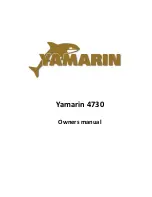
2. Ships service or “House” bank comprised of
two GR31 flooded lead acid batteries located
on the port side in the lazarette.
(see
Fig_6.2-2)
(Fig_6.2-2)
The “House” bank provides 12V power to most
onboard systems, lighting and controls, generator
(optional) and inverter (optional). The “Start” bank
provides power for high-draw, short cycle equipment
like engine starter motor and thruster motors. The
batteries in each bank are wired in parallel.
Monitoring the electrolyte level in all lead-acid
batteries, like the “Start” bank, is important. When
necessary to maintain the electrolyte level add only
distilled water.
Keep the terminals and tops of the batteries clean
and free from corrosion. Batteries should be kept fully
charged at all times. Low batteries will affect the
starting of the engine, and the operation of other 12V
DC systems. Batteries should never be allowed to
discharge over 50% of their capacity, as this can
shorten battery life.
Do not attempt to charge extremely low or dead
batteries with the alternator. The battery charger
should be used.
Do not expose batteries to sparks or open flames,
as the hydrogen given off during charging may
ignite.
C. 12V
Battery
Management
(see Fig_6.2-3)
(Fig_6.2-3)
Latching solenoid switches for the different 12V DC
systems are found on the starboard face of the
companionway. These include “ON/OFF” switches for
the ship’s service batteries, the engine start battery,
generator (optional), thrusters, and automatic
charging relay. These switches should be turned
“OFF” or “AUTO” when leaving the vessel
unattended.
Do not switch OFF the batteries from an engine
while it is running. Doing so may damage the
charging circuitry of the engine.
D. Automatic
Charging
Relay
Switch
The Back Cove 30 is equipped with an automatic
charging relay switch. (see Fig_6.2-3) Should the
engine start batteries go dead, this switch connects
the engine start circuit in parallel with the house
batteries. The house batteries can then be used to
start the engines. The emergency parallel switch
must be turned to AUTO after the engine starts and
left AUTO for all normal operation.
E. Electrical Distribution Panel, 12V DC
(Fig_6.2-4)
The 12V DC section of the electrical distribution
panel is located on the bulkhead aft of the galley on
the starboard side. (see Fig_6.2-4 thru Fig_6.2-5)
Power is fed to the distribution panel by means of the
“SHIP” latching solenoid. Power feeds to the load
groups distributed through individual circuit breakers
on this panel as well as to a sub panel breaker that
Summary of Contents for Back Cove 30
Page 1: ...Back Cove 30 Owner s Manual...
Page 30: ...5 0 V e s s e l O v e r v i e w 5 1 General Arrangement Cockpit Helm Deck Cabin...
Page 35: ...5 3 Mechanical Overview Lazarette Engine Room Forward Bilge Zone...
Page 61: ...Fig_6 12c 7 Fig_6 12c 8 Companionway Fig_6 12c 9 Mate Seat Footrests Companionway Catch s...
















































